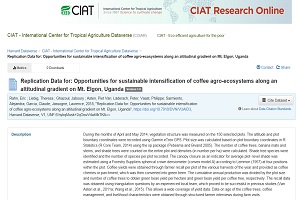Replication Data for: Opportunities for sustainable intensification of coffee agro-ecosystems along an altitudinal gradient on Mt. Elgon, Uganda
During the months of April and May 2014, vegetation structure was measured on the 150 selected plots. The altitude and plot boundary coordinates were recorded using Garmin eTrex GPS. Plot size was calculated based on plot boundary coordinates in R Statistics (R Core Team, 2014) using the sp package (Pebesma and Bivand 2005). The number of coffee trees, banana mats and stems, and shade trees were counted on the entire plot and densities (in number per ha) were calculated. Shade tree species were identified and the number of species per plot recorded. The canopy closure as an indicator for average plot- level shade was estimated using a Forestry Suppliers spherical crown densiometer (convex model A) according to Lemmon (1957) at four positions within the plot. Coffee yields were obtained through farmer recall per plot of the various harvests of the year and provided as coffee cherries or parchment, which was then converted into green been. The cumulative annual production was divided by the plot size and number of coffee trees to obtain green bean yield per hectare and green bean yield per coffee tree, respectively. The recall data was obtained using triangulation questions by an experienced local team, which proved to be successful in previous studies (Van Asten et al., 2011a; Wang et al., 2015). This allows a wide coverage of yield data. Data on age of the coffee trees, coffee management, and livelihood characteristics were obtained through structured farmer interviews during farm visits.

